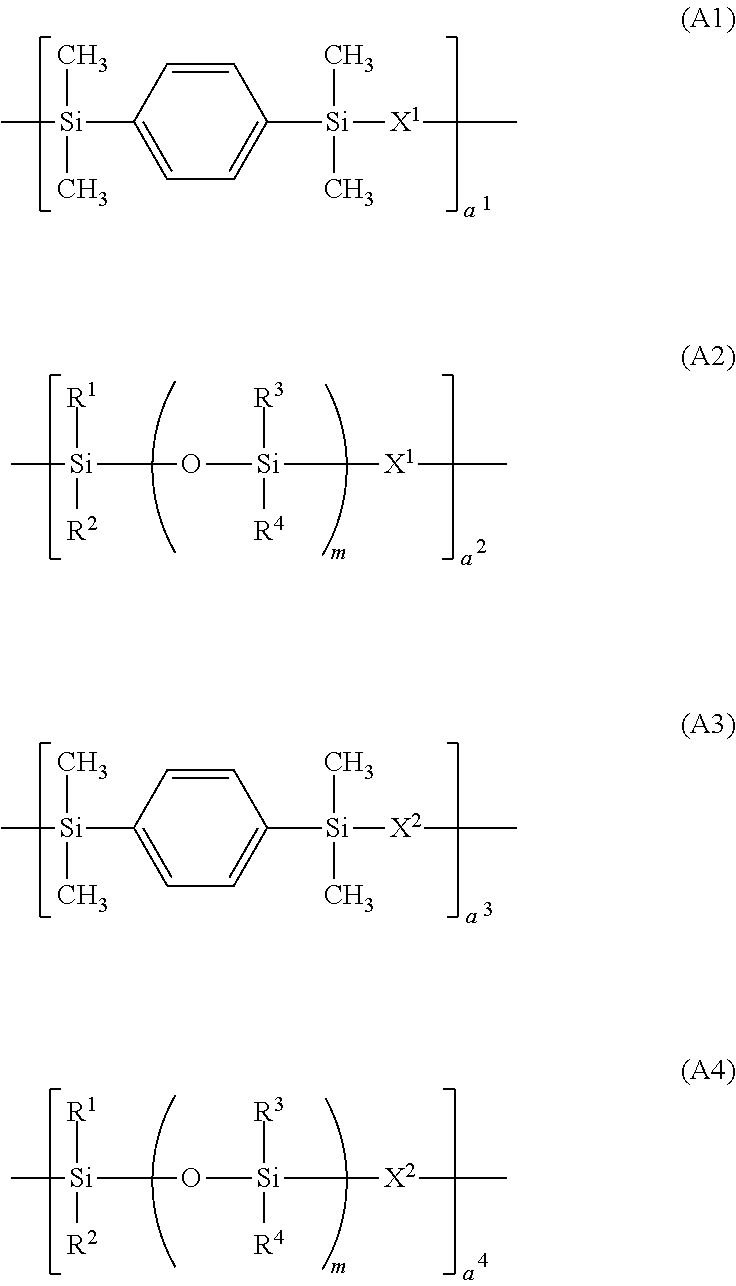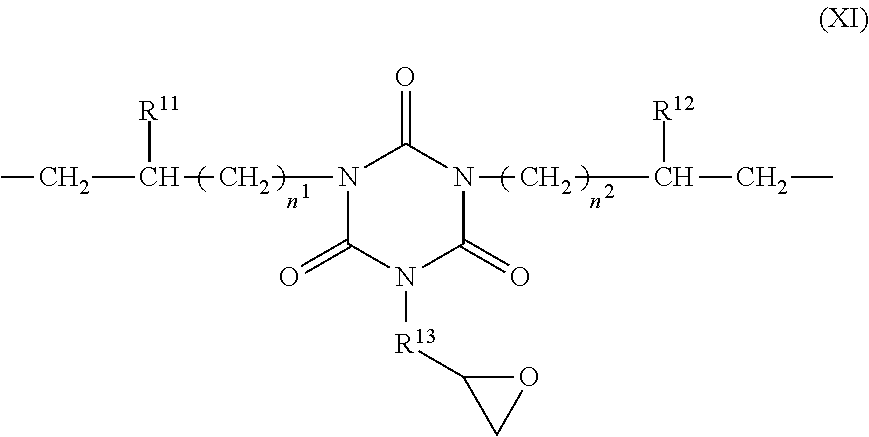Siloxane polymer containing isocyanuric acid and polyether skeletons, photosensitive resin composition, pattern forming process, and fabrication of opto-semiconductor device
a technology of isocyanuric acid and polyether skeleton, which is applied in the field of polysiloxane polymer containing isocyanuric acid and polyether skeleton, which can solve the problems of inability to clear the light resistance level needed for advanced optical devices, material inability to micro-processing, and inability to achieve light resistance, easy to synthesize, and high transparency
- Summary
- Abstract
- Description
- Claims
- Application Information
AI Technical Summary
Benefits of technology
Problems solved by technology
Method used
Image
Examples
example 1-1
[0117]Synthesis of Polymer 1
[0118]A 10-L flask equipped with a stirrer, thermometer, nitrogen purge line, and reflux condenser was charged with 132.5 g (0.50 mol) of Compound (S-4) and 269.5 g (0.50 mol) of Compound (S-3a), then with 2,000 g of toluene, and heated at 70° C. Thereafter, 1.0 g of a chloroplatinic acid toluene solution (Pt concentration 0.5 wt %) was added, and 116.4 g (0.60 mol) of Compound (S-1) and 1208.0 g (0.40 mol) of Compound (S-2a) were added dropwise over 1 hour (total hydrosilyl groups / total alkenyl groups=1 / 1 in molar ratio). After the completion of dropwise addition, the solution was heated at 100° C. and aged for 6 hours. From the reaction solution, the toluene was distilled off in vacuum, yielding Polymer 1. Polymer 1 had a Mw of 43,000 and a siloxane unit content of 70.0 wt %. On 1H-NMR analysis, Polymer 1 was found to consist of repeating units (A1) to (A4).
example 1-2
[0119]Synthesis of Polymer 2
[0120]A 10-L flask equipped with a stirrer, thermometer, nitrogen purge line, and reflux condenser was charged with 79.5 g (0.30 mol) of Compound (S-4) and 377.3 g (0.70 mol) of Compound (S-3a), then with 2,000 g of toluene, and heated at 70° C. Thereafter, 1.0 g of a chloroplatinic acid toluene solution (Pt concentration 0.5 wt %) was added, and 174.6 g (0.90 mol) of Compound (S-1) and 158.5 g (0.10 mol) of Compound (S-2b) were added dropwise over 1 hour (total hydrosilyl groups / total alkenyl groups=1 / 1 in molar ratio). After the completion of dropwise addition, the solution was heated at 100° C. and aged for 6 hours. From the reaction solution, the toluene was distilled off in vacuum, yielding Polymer 2. Polymer 2 had a Mw of 83,000 and a siloxane unit content of 20.1 wt %. On 1H-NMR analysis, Polymer 2 was found to consist of repeating units (A1) to (A4).
example 1-3
[0121]Synthesis of Polymer 3
[0122]A 10-L flask equipped with a stirrer, thermometer, nitrogen purge line, and reflux condenser was charged with 26.5 g (0.10 mol) of Compound (S-4) and 485.1 g (0.90 mol) of Compound (S-3a), then with 2,000 g of toluene, and heated at 70° C. Thereafter, 1.0 g of a chloroplatinic acid toluene solution (Pt concentration 0.5 wt %) was added, and 135.8 g (0.70 mol) of Compound (S-1) and 475.5 g (0.30 mol) of Compound (S-2b) were added dropwise over 1 hour (total hydrosilyl groups / total alkenyl groups=1 / 1 in molar ratio). After the completion of dropwise addition, the solution was heated at 100° C. and aged for 6 hours. From the reaction solution, the toluene was distilled off in vacuum, yielding Polymer 3. Polymer 3 had a Mw of 8,000 and a siloxane unit content of 42.3 wt %. On 1H-NMR analysis, Polymer 3 was found to consist of repeating units (A1) to (A4).
PUM
| Property | Measurement | Unit |
|---|---|---|
| thickness | aaaaa | aaaaa |
| transmittance | aaaaa | aaaaa |
| thickness | aaaaa | aaaaa |
Abstract
Description
Claims
Application Information
 Login to View More
Login to View More - R&D
- Intellectual Property
- Life Sciences
- Materials
- Tech Scout
- Unparalleled Data Quality
- Higher Quality Content
- 60% Fewer Hallucinations
Browse by: Latest US Patents, China's latest patents, Technical Efficacy Thesaurus, Application Domain, Technology Topic, Popular Technical Reports.
© 2025 PatSnap. All rights reserved.Legal|Privacy policy|Modern Slavery Act Transparency Statement|Sitemap|About US| Contact US: help@patsnap.com



